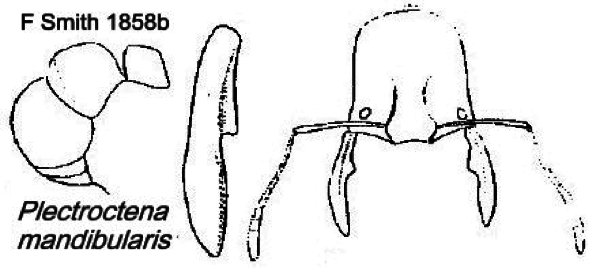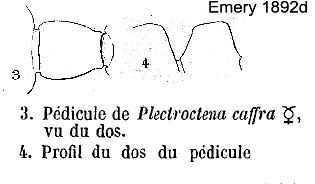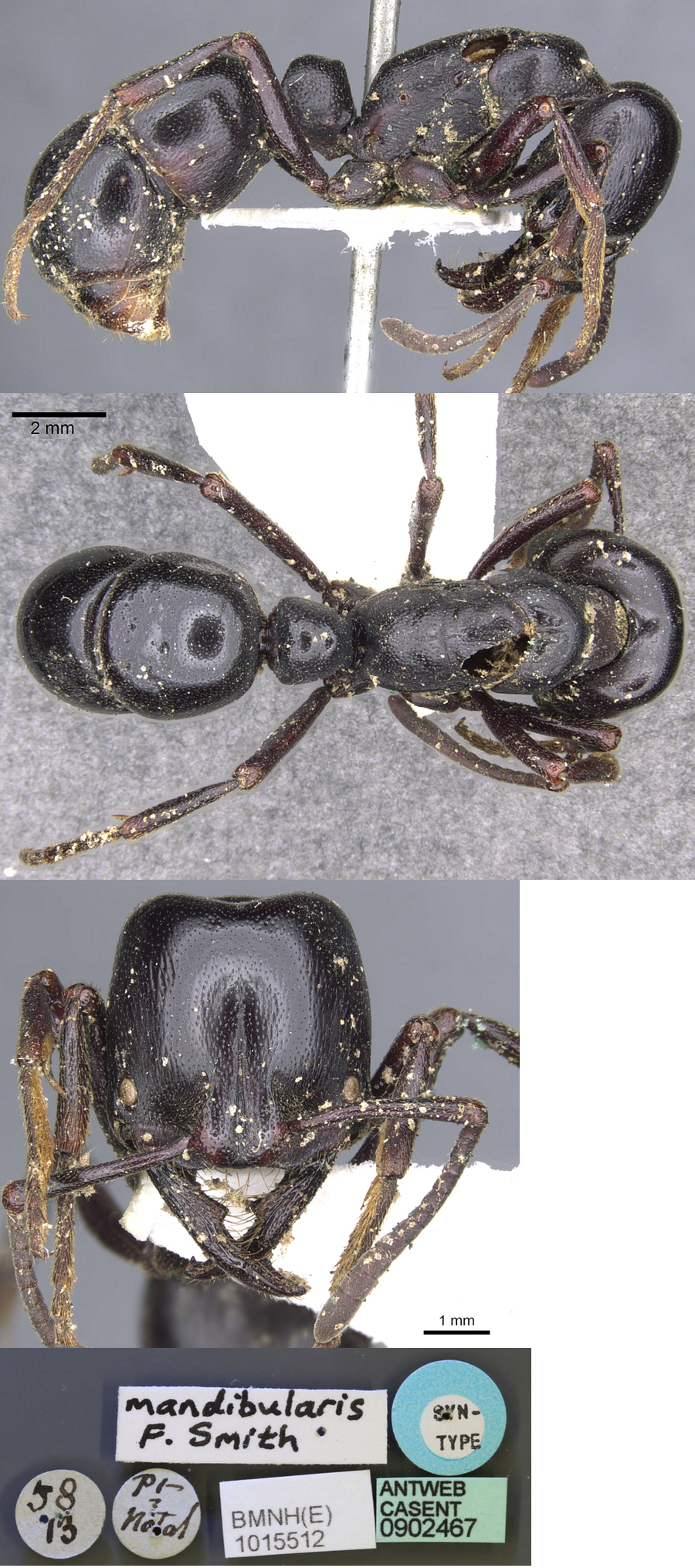Plectroctena mandibularis F. Smith
  Type location South
Africa (Plectroctena mandibularis,
F. Smith, 1858b: 101, illustrated, male & ergatoid
queen) Port Natal - see below Type location South
Africa (Plectroctena mandibularis,
F. Smith, 1858b: 101, illustrated, male & ergatoid
queen) Port Natal - see below
junior synonyms
caffra (Ponera
caffra Kt. M. B.,
Spinola,
1853: 70, nomen
nudum, synonymy Roger, 1861: 41, all forms)
major (Plectroctena
caffra Klug r. P. major
n. stirps, Forel,
1894b: 74, ergatoid queen) from Mozambique, Delagoa, P Berthoud
- see http://www.antweb.org/specimenImages.do?name=casent0907335
integra (Plectroctena
mandibularis Sm. var. integra
n. var., Santschi,
1924a: 161, worker & male) from Kenya, Nairobi, Ch.
Alluaud, 1904 - see http://www.antweb.org/specimenImages.do?code=casent0915290
strialiventris (Plectroctena
mandibularis Sm. stirps strigosa
Em. var. strialiventris
Stitz,
in Santschi, 1924a: 162, worker) from Tanzania (Lake
Tanganyika; wrongly given as "Malawi" by Bolton, 1974b & 1995:
338) - see https://www.antweb.org/specimenImages.do?code=focol1014
all forms described (Bolton, 1995)  . .
|
 Note - Plectroctena
caffra Klug is referred to
by Spinola (1853) whose paper dealt with Hymenoptera from Brazil,
collected by Ghiliani, as caffra KL.M.B = Klug (J.C.?),
Museé de Berlin. Emery (1982d: 556) defined P. minor (see
below) by comparison with P. caffra giving an accurate
illustration of the latter. Also Forel (1894) referred to P caffra,
the name, however, is regarded as a nomen nudum by Bolton
(1974b). In his Catalogue, Emery (1911d: 95, with the illustration)
listed it as a synonym of P. mandibularis F Smith - Formica
caffra (Klug) Spinola (1853) "pas de description". Thus, it seems
the Klug description either was not published or was lost or the name
simply was on a label of a specimen in the Berlin Museum. Note - Plectroctena
caffra Klug is referred to
by Spinola (1853) whose paper dealt with Hymenoptera from Brazil,
collected by Ghiliani, as caffra KL.M.B = Klug (J.C.?),
Museé de Berlin. Emery (1982d: 556) defined P. minor (see
below) by comparison with P. caffra giving an accurate
illustration of the latter. Also Forel (1894) referred to P caffra,
the name, however, is regarded as a nomen nudum by Bolton
(1974b). In his Catalogue, Emery (1911d: 95, with the illustration)
listed it as a synonym of P. mandibularis F Smith - Formica
caffra (Klug) Spinola (1853) "pas de description". Thus, it seems
the Klug description either was not published or was lost or the name
simply was on a label of a specimen in the Berlin Museum.
|
 F Smith's (1858b)
description is at F Smith's (1858b)
description is at  Spinola's (1853) note on
caffra is
at Spinola's (1853) note on
caffra is
at  Roger's (1861) note is
at Roger's (1861) note is
at  Emery's (1892d)
description of minor makes extensive comparison with P.
caffra; see Emery's (1892d)
description of minor makes extensive comparison with P.
caffra; see  Forel's (1894b)
description of major is at Forel's (1894b)
description of major is at  . Arnold's (1915: 86) description of major
is at . Arnold's (1915: 86) description of major
is at  and and  . Santschi's (1924a) description of strialiventris
is at . Santschi's (1924a) description of strialiventris
is at  . Santschi's (1924a)
description of integra is at . Santschi's (1924a)
description of integra is at  . Bolton's modern description (1974b) is at . Bolton's modern description (1974b) is at

|
  WORKER - large, TL 15.5-24.1 mm; separation as in the key
(Bolton, 1974b: 326, not illustrated); illustration of pedicel from
Emery (1892d, Plate 15). Bolton (1974b) wrote of males of conjugata
having totally black gasters whereas those of mandibularis have
red or orange-brown gasters. The images on www.Antweb.org at http://www.antweb.org/getComparison.do?rank=species&genus=plectroctena&name=mandibularis&project=&project=,
if anything confuse the situation. WORKER - large, TL 15.5-24.1 mm; separation as in the key
(Bolton, 1974b: 326, not illustrated); illustration of pedicel from
Emery (1892d, Plate 15). Bolton (1974b) wrote of males of conjugata
having totally black gasters whereas those of mandibularis have
red or orange-brown gasters. The images on www.Antweb.org at http://www.antweb.org/getComparison.do?rank=species&genus=plectroctena&name=mandibularis&project=&project=,
if anything confuse the situation.
Note - included as Wheeler (1922) listed a finding from Cameroun,
by Conradt (presumably at Mundame); apparently not detected by Bolton,
who (like Wheeler) gave very many African locations in countries east
and south of Cameroun.
Bolton & Brown (2002) added numerous findings from Botswana,
Burundi, Kenya, South Africa and Tanzania,
strengthening the suspicion that it is not known from West Africa or
the Congo Basin. Indeed, in their key, Bolton & Brown (2002) list
only east and southern African countries.
Nests in soil, deep below the surface, with no more
than about 50 individuals; feeds primarily on millipedes and beetles,
also termites.
|
 The
photomontage of a syntype ergatoid queen is collated from http://www.antweb.org/specimen.do?name=casent0902467. The
photomontage of a syntype ergatoid queen is collated from http://www.antweb.org/specimen.do?name=casent0902467.
|
Oxford University Museum
specimens
Plectroctena mandibularis
B Taylor det.
|
South Africa
S Danflous
|
16.xii.2007
Elandskrans
x°x'x" S y°y'y" E
|
iWestern Cape; z m; nest under a
stone.
|
2
|
 |
|
 The
photomontage is
of worker specimens collected from
South Africa, Elandskrans, Western Cape; collector Sam
Danflous. The
photomontage is
of worker specimens collected from
South Africa, Elandskrans, Western Cape; collector Sam
Danflous.
|
 The photomontage is
collated from http://www.antweb.org/specimen.do?name=SAM-HYM-C008861B. The photomontage is
collated from http://www.antweb.org/specimen.do?name=SAM-HYM-C008861B.
|
 The photomontage of a male collected with workers is
collated from http://www.antweb.org/specimen.do?name=SAM-HYM-C008861B. The photomontage of a male collected with workers is
collated from http://www.antweb.org/specimen.do?name=SAM-HYM-C008861B.
|
|